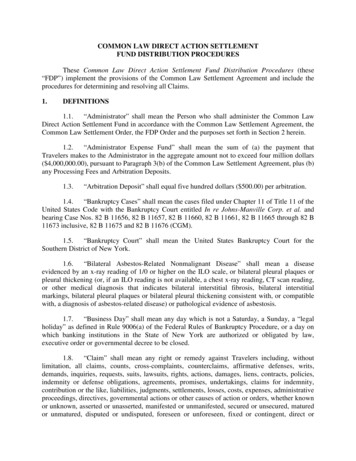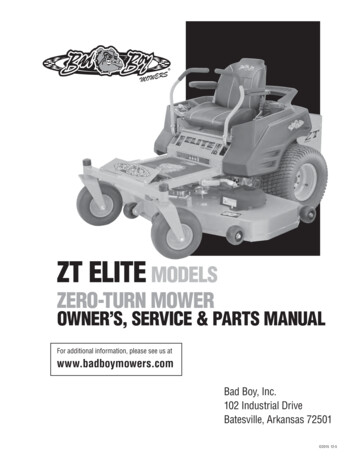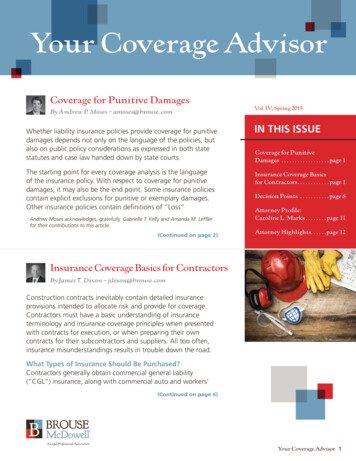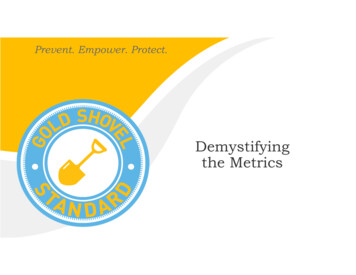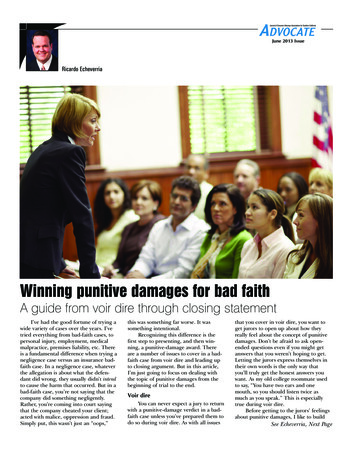
Transcription
June 2013 IssueRicardo EcheverriaWinning punitive damages for bad faithA guide from voir dire through closing statementI’ve had the good fortune of trying awide variety of cases over the years. I’vetried everything from bad-faith cases, topersonal injury, employment, medicalmalpractice, premises liability, etc. Thereis a fundamental difference when trying anegligence case versus an insurance badfaith case. In a negligence case, whateverthe allegation is about what the defendant did wrong, they usually didn’t intendto cause the harm that occurred. But in abad-faith case, you’re not saying that thecompany did something negligently.Rather, you’re coming into court sayingthat the company cheated your client;acted with malice, oppression and fraud.Simply put, this wasn’t just an “oops,”this was something far worse. It wassomething intentional.Recognizing this difference is thefirst step to presenting, and then winning, a punitive-damage award. Thereare a number of issues to cover in a badfaith case from voir dire and leading upto closing argument. But in this article,I’m just going to focus on dealing withthe topic of punitive damages from thebeginning of trial to the end.Voir direYou can never expect a jury to returnwith a punitive-damage verdict in a badfaith case unless you’ve prepared them todo so during voir dire. As with all issuesthat you cover in voir dire, you want toget jurors to open up about how theyreally feel about the concept of punitivedamages. Don’t be afraid to ask openended questions even if you might getanswers that you weren’t hoping to get.Letting the jurors express themselves intheir own words is the only way thatyou’ll truly get the honest answers youwant. As my old college roommate usedto say, “You have two ears and onemouth, so you should listen twice asmuch as you speak.” This is especiallytrue during voir dire.Before getting to the jurors’ feelingsabout punitive damages, I like to buildSee Echeverria, Next Page
By Ricardo Echeverria — continued from Previous Pageup to it by asking a series of questionslike the following:Q: Mr. Jones, do you think that sometimes people simply make honest mistakes and really didn’t mean to causeharm?A: Sure, of course they do. We’re allhuman after all and humans make mistakes.Q: And do you think that sometimespeople don’t just make mistakes, but theymight do things with a bad motive tobenefit themselves and in the processcause harm to others?A: I’m sure that happens too.Q: Do you think that sometimes, peopledo things to try to cheat other people outof money for their own benefit?A: Well, yeah, you hear about that all thetime.Q: Do you think that as a society we oughtto treat those two types of conduct differently? In other words, conduct which is anhonest mistake that causes harm versusdishonest conduct that causes harm?A: Sure, if the evidence proves that.I like to open up this dialogue withother jurors with questions like, “How do youfeel about that?”; “What are your thoughts?”;“Do you agree or disagree?” etc. At thispoint, you’ll find that most people will agreewith the basic concept that people can causeharm to others both honestly and dishonestly. You’ll also find that most people will agreewith the notion that honest and dishonestconduct should be treated differently.Now you have prepared the jurorsfor a discussion about punitive damages.Inevitably, there will be some jurors whohave heard or read about punitivedamages and have negative feelings aboutit. For example, I’ve had more than onejuror describe their understanding ofpunitive damages as “Isn’t that where theplaintiff gets a big windfall?” To help getjurors to understand the concept of punitive damages, I like to refer to them as“penalty damages” or “punishment damages.” I ask questions like:* “Ms. Smith, what do you think about asystem that allows for civil penalty damages if the conduct was dishonest, andnot just an honest mistake?”* “Mr. Jones, what do you think about asystem that allows for civilly prosecutingdishonest conduct in cases like this?”* “Ms. Evans, do you think that we as asociety should punish dishonest conduct?If so, why?”One of the things I’ve noticed in thepast several years is that jurors, generallyspeaking, are more receptive to the concept of punitive damages. I’ve found thisto be true even in conservative jurisdictions. I think the reason is because mostjurors have heard about corruption caseswhere people have cheated other peopleout of money. I bring up examples like,Bernie Madoff, Charles Keating, JeffreySkilling, and Enron to get jurors thinkingabout it. Examples like these bring up thenotion that sometimes greed causes people and/or corporations to do bad thingsand in the process cause harm to others.In a bad-faith case, the purpose ofpunitive damages is to punish and deterdishonest conduct. Ultimately, the goal invoir dire is to have jurors who are opento awarding punitive damages if they findthe evidence establishes dishonest conduct. The jury should also understandthat the purpose of punitive damages isnot to compensate, but to punish anddeter.Opening statementWe all know that opening statementis the time to tell your client’s story. It’s atime to showcase why the defendant’sconduct was wrong and to demonstratethe harm that your client suffered. Aftertelling my client’s story and showcasingthe bad conduct of the insurance company, I make it a point to explain that thereare two purposes to the case. The firstpurpose of the case is to compensate myclient and to make up for the harmcaused. I then talk about the damagesthat I intend to prove and the basis forthose damages. But in a bad-faith case,you can’t stop there. I also talk about thesecond, and more important, purpose ofthe case: to make sure this conduct ispunished and never repeated. In a bifurcated trial, I explain at the end of theopening statement that we will be looking for a finding of malice, oppression orfraud, so that the jury can get to the second phase to address what the appropriate punishment should be.June 2013 IssueCross-examination of the adjustersThe most important evidence youcan develop in a bad-faith case is duringthe cross-examination of the claimsadjusters. Cross-examination of thedefendant’s witnesses is usually when thejurors are on the edge of their seats. Thisis especially true in bad-faith cases.In every bad-faith case there is a dispute about the amount of money paidon the claim. Sometimes there’s a dispute about coverage and nothing hasbeen paid. Other times there is a valuation dispute and a claim of low-balling.Regardless, there is always that one finalletter or e-mail from the adjuster thattells your client “We’re done! You getnothing more!”I like to cross-examine the adjusterwith simple questions like the following:Q: Sir, when you adjust a claim, do youwant your policy holder to believe youwhen you communicate with them?A: Of course.Q: Do you want your policyholder to feelthat you’re telling them the truth?A: Sure.Q: Do you want your policyholder tohave confidence in what you tell them?A: Yes, I do.Q: And, in this case, when you sent thisletter telling my client that their claimwas denied and would not be paid, whatwould have happened if my clientsbelieved you?A: Well, I guess we wouldn’t be here.Q: Right, the claim would have beenclosed and no payment would have beenmade, correct?A: I believe that would be true.Now, these are pretty simple conceptsthat really can’t be disputed. After all, noadjuster is going to say that he/she doesnot want their policyholder to believethem. The reason I ask these questions isbecause if you get to the second phase,the jury will necessarily have found thatthe conduct was malicious, oppressive orfraudulent. During that time, you will beable to ask the jury the rhetorical question, “What would have happened if myclient just believed and trusted their insurance company?” Well, the answer comesSee Echeverria, Next Page
By Ricardo Echeverria — continued from Previous Pagefrom the defendant’s own witnesses: yourclient would have been cheated out ofmoney they deserved.Establishing ratificationIn order to get to a second, punitivedamage phase, you will need to provethat the conduct constituted “malice,oppression, or fraud” in phase I. (See,CACI 3946.) In addition, you will alsoneed to prove one of the following:1. That the conduct constituting malice,oppression, or fraud was committed byone or more officers, directors, or managing agents of defendant who acted onbehalf of the defendant; or2. That the conduct constituting malice,oppression, or fraud was authorized byone or more officers, directors, or managing agents of defendants; or3. That one or more officers, directors,or managing agents of defendant knewof the conduct constituting malice,oppression, or fraud and adopted orapproved that conduct after it occurred.”Going into trial, you need to identifythe witness or witnesses that have themanagerial capacity to establish ratification. In most cases it is either the immediate supervisor of the adjuster or thatperson’s supervisor. Whoever the witnessis, you need to establish ratification ofthe conduct in order to get to a second,punitive damage phase.On cross-examination of the supervisor, you will want to first establish thatgiven his/her role in the company, he/shehas managerial capacity. Once that isestablished, you need to confirm ratification and approval of the claim. I usuallyask questions like the following:* “Sir, there is nothing that you thoughtthe company did wrong in handling thisclaim, is that true?”* “As the supervisor, you approve of themanner in which this claim was handled?”* “In fact, this claim was handled in themanner in which the company strives tohandle claims, is that true?”* “There were no changes made to thecompany’s claim-handling guidelines as aresult of this claim, is that true?”* “Any other insured of this companycould expect to receive the same treatmentthat my client received in this claim, isthat true?”*”No one was reprimanded for work theydid on this file, is that true?”These questions establish not onlyratification but also pattern and practice.Inevitably, in phase I, the company andits witnesses will vigorously defend theirconduct and stand behind it. Of course,if the jury finds that the same conductwas malicious, oppressive or fraudulentand there is a second phase, this testimony will be very helpful to address theamount of punitive damages the juryshould award.The phase II trialTrying cases is kind of like being in aboxing match. You’re fighting every dayand whether you think it’s going well ornot, you just don’t know if you’re aheador behind on the jury’s scoring card.That’s why, like a boxer, no matter ifyou’ve had a good or bad day in trial,you shake it off and go into the next dayto fight again.But all of that changes when the juryhas made a finding of malice, oppressionor fraud and you find yourself now inphase II of the bifurcated trial. My partner and mentor, Mike Bidart, taught meearly on that when you get to the secondphase, you have to remember that thejury is on your side and has found, byclear and convincing evidence, thatthe insurance company’s conduct was“despicable” or fraudulent. So, as Mikesaid to me, your demeanor needs to belike the heavyweight champion who isbeing interviewed after defending histitle. You no longer need to be theaggressive fighter who is zealously arguing every issue. The jury has alreadyfound that the conduct is really bad, nowit’s the time to calmly reason with thejury about what to do about it. I remindthe jury that we are doing this collectively, on behalf of society, to make sure thisbad conduct is both punished, and moreimportantly, not repeated. Phase II opening statementPhase II is really a mini trial in itself.Accordingly, I always give a short opening statement before the beginning ofthe second phase. Contrary to a lot ofJune 2013 Issueother lawyers, I’m not big on thankingthe jurors, even after they have ruled inmy client’s favor on phase I. I’m not really sure why I don’t like it but maybe it’sbecause I’ve served on two juries myselfand when the lawyer constantly thankedus during closing argument I justthought it was patronizing. So instead, Ijump right into the purpose of the second phase. I will start off by saying something like this:Ladies & gentlemen, we have nowcompleted phase I of this case withyour verdict. As I stated, the purposeof the first phase was to compensatemy client, and you’ve now done that.But we now leave my client, and thefocus is now 100 percent on the defendant and its conduct. The purpose ofthis second, and most important,phase is to determine what we as asociety are going to do about punishing this conduct, and making sure thatit doesn’t happen again. And this is avery, very serious and solemn proceeding. You have found the conduct of thiscompany to amount to malice, oppression and fraud by clear and convincingevidence. That is the highest form ofmisconduct you can find in a civil caselike this so, as you can imagine, this isa very serious proceeding to determinethe appropriate punishment for thisconduct.I tell the jury that the only new evidence that they will hear is the financialcondition of the insurance company. Iexplain that the second phase is so sacredthat we are not even allowed to talk aboutthe money the defendant has during phaseI because we don’t want it to in any wayinfluence their decision about whether theconduct was malicious, oppressive orfraudulent. Simply put, we wanted a pristine and objective finding from them aboutthe conduct, which we now have.I usually finish the brief opening byletting the jury know that after they getthe evidence of the worth of the insurance company, there will be closing arguments at which time I will be recommending an amount they should awardto accomplish the purpose of punishment and deterrence.See Echeverria, Next Page
By Ricardo Echeverria — continued from Previous Page Evidence of financial conditionThe only new evidence to presentduring the punitive-damage phase is ofthe company’s financial condition.Getting the financial information of aninsurance company is very simplebecause they are required to lodge thatinformation with the Department ofInsurance (“DOI”). I usually will obtaincertified copies of at least five years ofthe company’s financial statements filedwith the DOI. Also, because the financialdocuments are certified by the DOI, theyare self-authenticated.Usually, I will have retained a forensic economist to explain what the numbers in the financial documents mean tothe jury. While there are many ways toevaluate the financial condition of thecompany, the most common way is tolook at the company’s surplus. The documents obtained from the DOI will setforth the company’s assets, liabilities andsurplus. Notably, the liability will list notonly the actual losses paid but alsoreserved losses so that the remaining surplus is net of even potential claims thecompany has reserved for future payments. Once the financial condition evidence is presented, it is time for the finalclosing argument. The phase II final closingWhile you know that the jury thinksthe company’s conduct was really bad bythe second phase, you don’t know whatthey are willing to do about it. It is yourjob as the trial lawyer to motivate the juryto “send a message”, not just to thedefendant in your case, but also to theinsurance industry as a whole. The starting point is to make sure you explain thepurpose of punitive damages which istwofold: to punish & deter. Cite to thejury instruction as follows:The purposes of punitive damagesare to punish a wrongdoer for the conduct that harmed the plaintiff and todiscourage similar conduct in thefuture.(CACI 3949)It is important that the jury understand that punitive damages are designedto protect the public, which includes themembers of the jury. One way to accomplish this task is to refer the jury back tothe law. For example, in California, onepowerful jury instruction is the following:The purpose of punitive damages ispurely a public one. The public’s goal isto punish wrongdoing, and therebyprotect itself from future misconduct,either by the same defendant or otherpotential wrongdoers. In determiningthe amount of punitive damages to beawarded, you are not to give any consideration as to how the punitive damages will be distributed.(Adams v. Murakami (1991) 54 Cal.3d 105,110; Neal v. Farmers Ins. Group (1978) 21Cal.3d 910, 928, fn 13) (emphasis added).Thus, in the punitive phase, portrayyour role as being one of a public servant. You are advancing the “public’sgoal” which is, in part, to punish thedefendant’s misconduct. Ultimately, thejury should understand that their punitive verdict will protect not just an individual or some special-interest group, butrather, will protect everyone from futureabuses. The jury must understand theimportance of their role of protecting thepublic in the punitive phase.It is important that the jury understand that they have the power to send awarning to the insurance industry thatmisconduct will not be tolerated by thepublic. The jury can do this by setting anexample of the defendant. Again, oneway to accomplish this is to refer back tothe jury instructions, such as the following from the United States SupremeCourt:In addition to actual or compensatory damages which you have alreadyawarded, the law authorizes the jury tomake an award of punitive damages inorder to punish the wrongdoer for itsmisconduct or to serve as an example orwarning to others not to engage in suchconduct.(TXO Production Corp. v. Alliance ResourcesCorp. (1993) 509 U.S. 443, 459, 463,emphasis added (“TXO”).)The punitive damages that the juryawards will not only send a message tothe defendant on how it should do business in the future, but it will also serve asan example or a warning to other competing companies that the public will nottolerate such misconduct. Give the juryJune 2013 Issueexamples of warnings they see everyday:if a swimming pool is too shallow, itshould have a warning; if a product isdangerous, it should have a warning; if afloor is slippery, it should have a warning, etc. Warnings like these must beprominently displayed in order to havean impact. In your case, the punitivedamage award will serve as a warning toother insurance companies and so itmust be a meaningful amount to beprominently displayed to the industry.I like to emphasize the second purpose of punitive damages which is deterrence. The jury’s verdict should not onlydeter future wrongdoing by the defendant, but also by the industry as a whole.Another effective jury instruction toestablish this point is the following:The object of [punitive] damages isto deter the defendant and others fromcommitting like offenses in the future.Therefore, the law recognizes that to infact deter such conduct, may require alarger fine upon one of larger meansthan it would upon one of ordinarymeans under the same or similar circumstances.(TXO, 509 U.S. at p. 463, emphasisadded).Once the jury understands the“purely public” purpose of punitivedamages, it is then time to turn to theamount of punitive damages to assess.The guidelines for the assessment ofpunitive damages include the following:1.) how reprehensible was the conduct?2.) is there a reasonable relationshipbetween the amount of punitive damagesand the harm? and 3.) in view of thefinancial condition of the defendant,what amount is necessary to punish anddiscourage future wrongful conduct?(See, CACI 3949)Naturally, the evidence under eachof these guidelines will largely depend onthe facts of a given case as to the reprehensibility of the conduct, the defendant’s financial condition, and the plaintiff ’s actual injury. These facts must bepresented in evidence and then arguedspecifically to the jury. In addition tothese general guidelines, there are otherauthorities that speak more specifically toSee Echeverria, Next Page
By Ricardo Echeverria — continued from Previous Pagethe amount of punitive damages. Takethe following jury instruction:In determining the amount of punitive damages to be assessed against adefendant, you may consider the following factors: One factor is the particular nature of the defendant’s conduct.Different acts may be of varyingdegrees of reprehensibility, and themore reprehensible the act, the greater theappropriate punishment. Another factorto be considered is the wealth of thedefendant. The function of deterrence andpunishment will have little effect if thewealth of the defendant allows it to absorbthe award with little or no discomfort.”(Neal v. Farmers Ins. Exchange (1978) 21Cal.3d 910, 928) (emphasis added).These jury instructions convey credibility to your argument on the amount ofpunitive damages the jury should award.In other words, the jury should be toldthat the law requires a greater punitivedamage award where the conduct is particularly reprehensible, and that the lawrequires that the amount the jury awardsin punitive damage must cause somefinancial “discomfort”, in order to servethe public purpose of deterrence as discussed earlier. Naturally, determiningwhat amount will cause the appropriate“discomfort” will depend on the financialcondition of the defendant. This conceptis further set forth in another juryinstruction:The wealthier the wrongdoingdefendant, the larger the award of punitive damages needs to be in order toaccomplish the objectives of punishment and deterrence of such conductin the future.”(Adams v. Murakami, (1991) 54 Cal.3d105, 110) (emphasis added).When asking for an amount of punitive damages, I like to remind the jurythat this corporate defendant must betreated the same as an individual in theeyes of the law. I refer to the followinginstruction:A corporation, ABC InsuranceCompany, is a party in this lawsuit.ABC Insurance Company is entitled tothe same fair and impartial treatmentthat you would give to an individual.You must decide this case with the samefairness that you would use if you weredeciding the case between individuals.(CACI 104) (emphasis added).When arguing this instruction I tellthe jury that we all know what it means totreat the defendant the “same.” We don’ttreat them any worse, but we don’t treatthem any better either. We treat them the“same.”I ask the jury to consider that ifinstead of this insurance company thatcheated my client out of money it was anindividual who had a net worth of 100,000. What would they say? Well, itcomes down to three things. First, wewould say, “give the money back.” Iremind the jury that the purpose ofphase I was just that; to give the moneyback to my client. The second thing wewould say to that individual is “you’regoing to jail.” Why? Because people whocheat other people out of money go tojail. It’s called a white-collar crime. I tellthe jury that we can’t put a corporationin jail so, at least to that extent, we reallycan’t treat them the same as an individual. The third and final thing we wouldsay is that the individual must be punished with a penalty. Some penalty tomake sure the misconduct is not repeated.June 2013 IssueI explain that to an individual with anet worth of 100,000, a minor penaltyof 5,000 or even 10,000 amounts to 5percent to 10 percent of that person’s networth. Yet, that same 5 percent or 10percent is a much greater amount toan insurance company that has a networth/surplus in the millions or even billions. But, equating what a reasonablepunishment would be to an individual, towhat it would be to the insurance company, is treating the insurance company the“same” as an individual. No better andno worse.ConclusionGetting a punitive-damage verdict ina bad-faith case is not an easy task. Itrequires a great deal of preparationand organized thought before trial.Hopefully, this article will help you indealing with the issue of punitive damages during the trial of a bad-faith casefrom start to finish.Ricardo Echeverria is a partner with thelaw firm of Shernoff Bidart EcheverriaBentley LLP specializing in liability, property, and HMO cases within the firm’s HMOLitigation & Property/Casualty department.Ricardo Echeverria was the 2010 ConsumerAttorneys of Los Angeles Trial Lawyer of theYear and was nominated for the award in2006, 2007, 2008 and 2009. He wasalso a finalist for the Consumer Attorney ofCalifornia’s Consumer Lawyer of the Year in2007 and 2009. He also serves as the currentVice Chair of CAALA’s Education Committee.He has litigated a diverse variety of cases,including bad faith, construction defect, earthquake, wrongful death, personal injury andprofessional negligence against an insuranceagent.
I've had the good fortune of trying a wide variety of cases over the years. I've tried everything from bad-faith cases, to personal injury, employment, medical malpractice, premises liability, etc. There is a fundamental difference when trying a negligence case versus an insurance bad-faith case. In a negligence case, whatever

